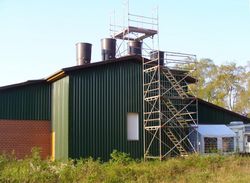Dossier
Exhaust air treatment in animal housing
Jochen Hahne | 30.06.2022
Exhaust air from animal husbandry contains particulate matter, bio-aerosols, ammonia and odorants – all in all undesirable substances. Approved exhaust air treatment systems can reduce these emissions effectively.

The point in animal husbandry is to improve housing techniques considering several objectives: Emission reduction, animal welfare and competitiveness. We develop technical processes to reduce the emissions of ammonia, trace gases, odorants and bio aerosols with exhaust air treatment. Meanwhile the exhaust air treatment has become an important instrument to minimize local conflicts and to secure facilities. In the field of poultry keeping, much development work is still required.


![[Translate to English:] Durch die Größe der Ställe und den hohen Tierbesatz entsteht viel Abluft mit unerwünschten Emissionen. The situation in poultry keeping](/media/_processed_/e/5/csm_Bild8_Huehnerhaltung_3006915f3d.jpg)
![[Translate to English:] Bioaerosols : Tiny particles, big effect](/media/_processed_/4/9/csm_Dossier_Emissionen_Hintergrund_Bioaerosole_8cad050cef.jpg)



